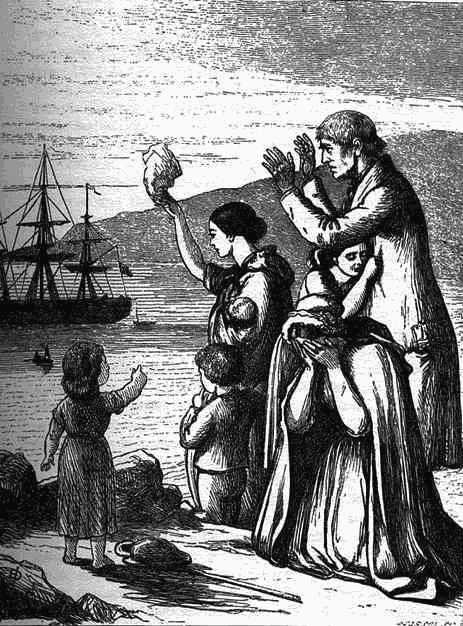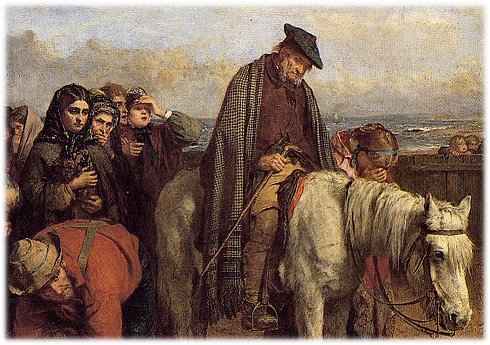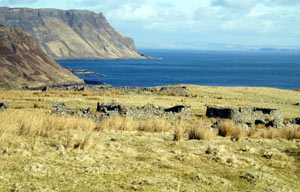
Prior to 1700, a great many people had left Scotland in search of better opportunities elsewhere. This continued a long-established pattern that had begun earlier. For example, royal policies in Ireland from the 1610s created a demand for settlers, especially in Ulster and some 30,000 to 50,000 Scots crossed the Irish Sea over the next three decades and another 50,000 going there in the 1690s. There was also a growing Scottish community in England as well as in English colonies in North America and the West Indies. The demand for soldiers on the continent also took as many as one in five young men. For the whole of the 17th century, emigration may have been as high as 250,000 people, helping to keep the total population relatively static.
In the 18th century, there was large scale migration within Scotland - much of this was short-distance movement in the countryside. But, with the industrial revolution and the Lowland Clearances, there was also a rural-to-urban migration and a corresponding Highlands-to-Lowlands migration. The Highlands were particularly vulnerable because of poor soil and lack of minerals that could sustain industry. The pressure of population on resources was becoming intolerable by the late 18th century and many Scots chose external emigration rather than internal migration. Some of that was driven by highland landlords forcing massive rent increases on tenants who left en masse for North America. At the same time, lowland landlords were forcing tenants off their lands - some would migrate to the cities, others to North America and Australia.
In the years immediately before the American Revolution, emigration from Great Britain (primarily from Scotland, Yorkshire, and London) to North America increased so dramatically as to be a matter of deep concern to the British government. Scottish emigrants tended to be whole families on the move. They came from no particular urban complex, nor did they come exclusively from the Highlands or the Lowlands. The landowners in Scotland were openly hostile to emigration because people were useful as tenants, labourers, and servants. The government too did not look favourably upon emigration, which might reduce the number of potential recruits to armed forces, because England was in continuous war during that period. Already, enthusiasm for military service had declined, as resentful Highlanders, driven to small unproductive holdings and forced to engage in unwanted tasks, took a modest revenge by ignoring the pressures of their chiefs when the recruiting officers came round.
The landed gentry managed to get the Ship's Passenger Act of 1803 passed which, under the guise of raising standards on emigrant ships, tried to price emigration beyond the pockets of most prospective emigrants. Their strategy failed. Emigration continued, especially to the United States. Things changed very rapidly when the wars ended in 1815. Fighting men were no longer wanted. Landowners quickly found that tenants were no longer an asset but were likely to become a burden. Thus in 1827 the restrictions of the Passenger Vessels Act were removed, and emigration was not only permitted but vigorously encouraged.

Emigration out of the Highlands has been well documented as the Highland Clearances. Starting around 1770, Highland products such as cattle, kelp, whiskey, wool, mutton, slate and timber became in high demand. This was due, in part to increased demand from the growing industrialization in the Lowlands. The Highlands also benefited from the elimination of comparable imports during the Napoleonic wars. Faced with high demand, landowners started to chase windfall profits on the increased prices by clearing the interior of the Highlands for large-scale farming of sheep. The organization of sheep-farming, unlike that of cattle, was incompatible with peasant husbandry. Accordingly, landlords forced the people off the land and towards the coast by raising rents. In one parish, rents rose 1000% between 1777 and 1805. At the time, the landowners' plan was to resettle the peasants in model villages where they would find employment of a non-agricultural nature. The crisis of the Highland Clearances came when the economy of the Highlands collapsed at the end of the Napoleonic wars.
The tragedy of the Highland Clearances can't be laid entirely at the feet of the landed gentry. Another contributing factor was a fall in prices for Highland products. The Highland had become a supplier of protein and raw materials for the newly-industrialized urban complexes, but in becoming that supplier, they became dependent on prices remaining high. Those high prices evaporated after the end of the Napoleonic wars. First, cattle prices were halved. Then, the renewed import of other cheaper, better products lead to the collapse of other products, for example, of the kelp prices which had sustained many families. The employment of highland youths in the military collapsed after 1815. Illicit whiskey distilling which enabled the Highlanders to turn their meager barely crops into easily transportable spirits came under aggressive new taxation. Landed gentry were not immune. Many lost their estates. Some of that was due to high living in London, but it was the collapse of so many markets simultaneously after 1815 that was so lethal.
The Clearances had previously been aimed at moving people out of the interior glens to crafting communities near the sea. Virtually, no landlord wanted to lose population. However, as the profitability of the cattle, kelp and fishing industries declined, major landholding families were bankrupted. After all, three out of the four profitable staple economies had just disappeared. Only sheep farming was producing any income. The prospects for the Highlands were grim. If nothing was done, the region would revert back to subsistence farming with an increasing number of peasants living in a vast rural slum existing off potatoes grown on smaller and smaller holdings (as parents divided up their holdings to bestow to their children). The alternative was for the region to switch over in a big way to sheep, with the best ground managed by a handful of outsiders and the natives existing by subsistence farming on the peripheries. For the landowner, the second option was preferable since it would avert his own ruin along with that of his dependents. However, it demanded ruthlessness in replacing men with sheep. Under such pressure, after 1820 landlords began to link assisted emigration with the idea of further clearances of population to make way for even more intensive sheep ranching. However, even the wool industry suffered price fluctuations and landlords found that they could not afford the expenditure needed to link organized emigration to eviction. In the 1840s, famine gave the final push to mass emigrations. For the Highlander, their grievance was not that the clearances had increased their poverty; it had not. It was that they had been evicted from land that they had occupied for time immemorial. Their landlord, their chief, had evicted them for animals!

Above, ruined remains of houses in Shiaba, a thriving town whose inhabitants were removed by the landowner so that he could rent the land to a single sheep farmer.
Robert Somers was a journalist for the North British Daily Mail and in 1848 he undertook an extended visit to the Scottish Highlands, sending back his observations in the form of a series of weekly letters to the paper. Later the articles were collected and published in book form as Letters from the Highlands. The picture that he paints is of a land where the landowners, in many cases absentee landlords, deliberately and systematically removed the indigenous population to make way for sheep farms and later sporting estates. Here's an excerpt from one of his letters.
The clearance and dispersion of the people is pursued by the proprietors as a settled principle, as an agricultural necessity……and the operation goes on in a quiet business-like way, that neither excites the remorse of the perpetrators, nor attracts the sympathy of the public……Every clearance produces misery and pauperism. It lessens the amount of work to be done in a parish, because the large farmers turn extensive tracts of soil into grass, on which the small tenants used to grow corn, turnips and potatoes. And while it diminishes the work to be done it increases the numbers of those who can only subsist by hiring themselves to do it. It grinds down small farmers into day-labourers. It is easy to perceive how inevitably a wretched and impoverished race of labourers is created by the clearances. Pauperism flows as certainly from the same source. When a small farmer was disabled by accident or sickness, the culture of his land went on as before, and his corn grew, and his cows gave milk as plentifully; but the same man when reduced to the position of a labourer, has no resources when disabled but the parish roll. And the old infirm people, who share the produce of the small farms occupied by their sons and daughters, necessarily become chargeable as paupers on the charity of the parish when the small farms are broken up and their offspring reduced to poverty and dependence.
(While Somers' comments were directed towards the Highlands, the principle extends to agricultural labourers in the Lowlands, people like Robert Wighton, a labourer for a large farm. We know that Robert died somewhat suddenly at the age of 58. Unlike earlier generations, he had no lease on land that his family could continue. Perhaps his son, Robert, saw the futility of this kind of life and decided that emigration gave him a brighter future.)
Robert Somers visited Blair Atholl and in particular Glen Tilt which had been depopulated some 60 to 70 years previously. Here are some more of his comments.
An event occurred at this period which afforded a pretext to the Duke for the heartless extirpation of his people. Highland chiefs were exhibiting their patriotism by raising regiments to serve in the American war; and the Duke of Atholl could not be indifferent to such a cause. Great efforts were made to enlist the Glen Tilt people, who are still remembered in the district as a strong athletic race. Perpetual possession of their lands, at the then existing rates, was promised them if they would only raise a contingent equal to a man from each family. Some consented, but the majority with a praiseworthy resolution not to be dragged at the tail of a Chief into a war of which they knew neither the beginning nor the end, refused. The Duke flew into a rage; and press gangs were sent up the glen to carry off the young men by force. By impressment and violence the regiment was at last raised; and when peace was proclaimed, instead of restoring the soldiers to their friends and their homes, the Duke, as if he had been a trafficker in slaves, was only prevented from selling them to the East India Company by the rising mutiny of the regiment! He afterwards pretended great offence at the Glen Tilt people for their obstinacy in refusing to enlist and - it may now be added - to be sold; and their conduct in this affair was given out as the reason why he cleared them from the Glen - an excuse which, in the present day, may increase our admiration of the people, but can never palliate the heartlessness of his conduct. His ireful policy, however has taken full effect. The romantic Glen Tilt, with its fertile holms and verdant steeps is little better than a desert. The very deer rarely visit it and the wasted grass is burned like heather at the beginning of the year to make room for new verdure. In the meantime it serves no better purpose than the occasional playground of a Duke.
Sources
Houston, R. A. and Knox, W. W. J. (2001). The New Penguin History of Scotland, London: Penguin Books.
Smout, T.C. (1998). A History of the Scottish People, London: Fontana Press.
Various websites, including:
Perthshire Diary: http://www.perthshirediary.com/html/day0103.html
Scotland: A Concise History (www.electricscotland.com/history/scotland/chap10.htm)